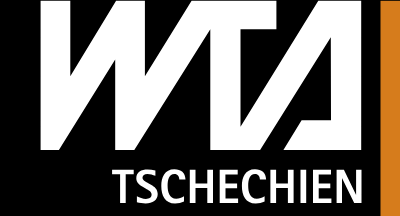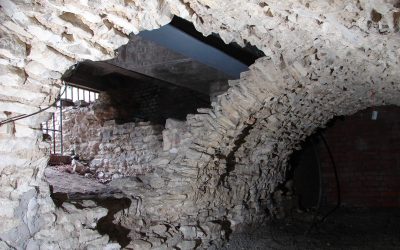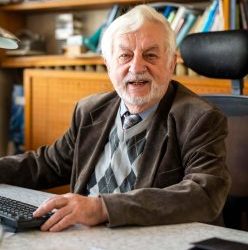Establishment of the Institute
- The history of the Klokner Institute began in 1912 when the group of professors of the Czech Technical University submitted the first official proposal for its establishment.
- At the beginning of 1921, the Civil Engineering Research Institute was officially established.
- In the first decades, the number of employees was variable according to the number of orders. On average, 10 to 13 employees were employed at the Institute.
- Today, we have approximately 90 competent experts and we believe that due to our wide range of operations, the Institute will continue to flourish in the next century of its existence.
František Klokner
František Klokner was born on 19 November 1872 in Karlín, Prague. Thanks to his abilities, he gained the attention of Professor Šolín and became his assistant. Josef Šolín was a great role model for František not only from a professional point of view but also for organizing public professional events.
- During his life, he was active both in practical life and on campus.
- In the role of a co-author, he participated in the creation of a large number of standards and at the same time acted as a forensic expert and technical advisor.
- In 1948, the Prague Capital awarded his scientific activity with the Křižík Prize, and in 1959 he was awarded the Order of the Republic.
- He was not forgotten even after his death when the Academician Klokner Award was established for his 100th birthday, which he did not live to see, and it is awarded by the Czech Society for Mechanics.
Bedřich Hacar
Within the celebrations, another personality who participated in the formation of our Institute, Bedřich Hacar, needs to be highlighted, too.
His life began on 24 May 1893 in Čechy pod Kosířem. At university, he simultaneously studied cultural engineering and a two-year so-called geometry course. During the construction mechanics lectures, he met František Klokner who fundamentally influenced his future. The thanks for the establishment of the Klokner Institute go to Bedřich Hacar as he managed to finally push through the establishment of the Institute in 1921. After the leaving of František Klokner, he became the second head of the Institute.
Wartime period
In the difficult wartime period, the Klokner Institute had an extraordinary position thanks to unique facilities and activities not only during the First Czechoslovak Republic but also during the Second World War. Unfortunately, other institutes were not so lucky. On 17 November 1939, the CTU was completely closed, the employees were ordered holiday, and the director of the Institute at the time urged reopening from his apartment.
The KI was reopened in May 1940 but due to the occupation of the testing premises by German soldiers it was not possible to carry out activities in a standard mode. Throughout the war period, orders for the German Empire were handled and Bedřich Hacar was awarded the unwanted Shield of Honour award of the Protectorate of Bohemia and Moravia. At the time of the Czechoslovakia liberation, he took a vacation to concentrate mainly on clearing his name.
Two institutes – the Klokner Institute and the Institute of Technical and Applied Mechanics of the Czech Academy of Sciences
The incorporation of the Klokner Institute into the Czechoslovak Academy of Sciences in 1952 was the result of the state’s efforts to create a stable organization of education, science and research that would correspond as closely as possible to the Soviet model. Especially in construction research, it was becoming clear that a strict institutional separation of the theoretical and practical part is not desirable.
The year 1963 is probably the biggest turning point in the history of the Institute. From that year, the dual history of the original Research and Testing Institute of Building Materials and Structures began to be written. For the Klokner Institute, this situation meant a return under the wings of the CTU after 10 years.
Non-work life of the Institute before the Velvet Revolution
The lives of employees were largely subject to the needs of the state. In the sense of the slogan “work socialistically, live socialistically”, the individual departments of the Institute were able to combine the pleasant with the useful and, thanks to their ingenuity, showed great activity. Visiting exhibitions and theaters was commonplace. Employees also undertook long-distance marches together (e.g., Prague-Prčice, The Path of Brdy Partisans, etc.).
- Popular activities also included domestic and foreign tours.
- In 1976, an expedition to Baikal took place.
- Camps were organized for the children of the employees.
- Among other things, the Institute organized a whole range of courses and lectures that expanded knowledge.
- In addition to pleasant and friendly activities, it was a matter of course for the employees to participate in events that expressed conformity with the ruling regime.
The Klokner Institute and its location
At the beginning of its existence, the Klokner Institute was a small workplace with a capacity of 10 to 13 employees. It was originally located in a wooden pavilion in the courtyard of the CTU campus on Charles Square where facilities were created for a test room, laboratories and offices. Soon the facility became insufficient but due to the world economic crisis at the time, it was not possible to move the Institute. In addition, the situation began to be complicated by the fact that the wooden pavilion was attacked by a wood rotting fungus. The head of the Institute was looking forward to the completion of the CTU premises in Dejvice with great anticipation. The moving took place in 1935, with the greatest difficulty being to ensure the smooth movement of the heavy test machines. In the new building on the Dejvice campus, the researchers had almost twenty times more work space at their disposal. In 1998, the Klokner Institute lost its property rights to the historical premises in Šolínova Street. In about 10 years’ time, we should look forward to a new building which will be located in the Motol premises in Prague.
Nusle Bridge
Of course, every one of us knows the Nusle Bridge but few know what preceded its ceremonial opening. In 1960, the city decided to use a prestressed concrete structure contrary to the original designs.
Construction of the bridge began in 1965 and lasted eight years. The course of the stress tests was remarkable and the employees of the Institute were present (one of them was the promising employee Petr Bouška who is still employed at the institute today). The KI was the first to take part in a static load test which took place on a rough construction site in the early 1970s.
- Army tanks were brought to the bridge to serve as loading elements.
- The tanks were gradually driving onto the bridge at different intervals.
- In the final total, about 600 tanks passed over the bridge.
- The second test, carried out by us, used trucks loaded with gravel and subway cars loaded with bags of cement as loads.
- Due to the relatively significant sensitivity of the structure to side effects (sunlight, temperature changes, etc.), it was necessary to perform the test at night.
Floods in 2002
In August 2002, there were large-scale floods in the Czech Republic, affecting a large part of Bohemia. Having penetrated into the basements and lower floors of the buildings, the flood water damaged many structures. The CTU reacted very quickly to the situation and offered its help to the City Hall of the Prague Capital and individual city districts.
The main organizers of all activities were Rector Jiří Witzany and Director of the Klokner Institute Tomáš Klečka. The Institute’s team, led by the then director and composed of Petr Bouška, Karel Kovář and Jiří Kolísko, compiled basic instructions for minimizing damage to structures affected by water.


